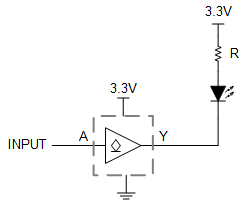Hello,
I’m using a SN74LVC1G07 device to sink current from an LED. I have a 2-part question about this:
1) For a VCC of 3.3V, the data sheet has 2 sets of I_OL numbers: 16 mA and 24 mA. Which of those two numbers should I be looking at in determining the maximum current I can sink?
2) In normal operation the input of this buffer is high until a Fault occurs in which it will drive it low which is when I’d like the LED to come on. My question is that since this is an open-drain buffer and in normal operation the input is high (meaning the output will be in High Z state), would I need to pull-up the output so that the LED will not drive the High Z and come on when no Fault condition has occurred? I’m thinking that I need to use the pull- up but would like to make sure.
Thank you for your support
Ray


